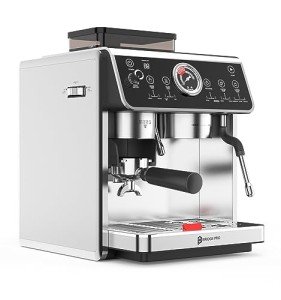Buzzwords De-Buzzed: 10 More Ways For Saying Heat Exchange Espresso Machines

Heat Exchange Espresso Machines: A Comprehensive Guide
Espresso machines have actually progressed considerably over the years, dealing with the needs of home baristas and coffee experts alike. Among these machines, heat exchange espresso machines have acquired appeal due to their capability to provide constant performance and exceptional brew quality. In this post, we will check out the operations, advantages, and important features of heat exchange espresso machines, offering a detailed understanding for both possible purchasers and coffee enthusiasts.
Comprehending Heat Exchange Technology
Heat exchange espresso machines run on a distinct principle that allows simultaneous water heating for brewing and steaming. They are equipped with a single boiler that utilizes a heat exchanger system. This feature is considerable as it makes it possible for users to brew espresso while steaming milk concurrently, promoting efficiency in the coffee-making procedure.
How Does a Heat Exchange Espresso Machine Work?
The process begins with the machine's water inlet filling the boiler. As the water warms up, it turns to steam. The innovative heat exchanger uses hot steam to heat additional water in a different passage developed particularly for the brew group. Energy-Efficient Espresso Machines means that water can reach the ideal brewing temperature without awaiting the boiler to adjust. The crucial steps consist of:
- Water Fill: Water is drawn into the boiler.
- Heating Process: The boiler warms up as water is transformed into steam.
- Heat Exchange: Steam warms water in the heat exchanger tube.
- Brewing: Water from the heat exchanger is pressed through coffee grounds, extracting the tastes needed for a rich espresso.
This procedure permits quick temperature modifications and improved coffee extraction.
Benefits of Heat Exchange Espresso Machines
Heat exchange espresso machines offer a number of advantages, particularly for those wanting to optimize their coffee experience. Here are some crucial benefits:
- Simultaneous Brewing and Steaming: Users can brew espresso while steaming milk, making it ideal for busy cafes and home baristas who value efficiency.
- Temperature Stability: The boiler's steam pressure helps keep a stable temperature, which is vital for constant espresso extraction.
- Flexibility: The style enables quick switching between developing and steaming, making it simpler to produce different coffee beverages, from lattes to coffees.
- User-friendly: Models often include accessible controls, making it possible for both newbies and experienced baristas to produce quality drinks.
- Professional Quality: Heat exchange machines are frequently utilized in commercial settings, offering users with high-quality developing performance at home.
Key Features to Look for in Heat Exchange Espresso Machines
When considering the purchase of a heat exchange espresso machine, there are numerous functions that one need to consider:
- Build Quality: Look for machines made of long lasting products, such as stainless-steel or brass, ensuring longevity.
- Boiler Size: A bigger boiler will hold more water and sustain greater output in time.
- PID Temperature Control: This feature assists keep constant brew temperature levels, which can enhance the coffee-making procedure.
- Group Head Design: Machines with a saturated or semi-saturated group head supply much better temperature stability.
- Relieve of Use: User-friendly user interfaces and user-friendly controls improve the total experience for baristas at all ability levels.
- Steam Wand Quality: A good steam wand with appropriate insulation and flexibility enables better texturing of milk.
- Water Reservoir Size: Depending on your needs, consider how often you desire to fill up the water reservoir.
Contrast of Popular Heat Exchange Espresso Machines
To better understand the options available in the market, listed below is a comparison table of some popular heat exchange espresso machines:
| Machine Model | Boiler Size | PID Control | Price Range | User Ratings |
|---|---|---|---|---|
| Profitec Pro 700 | 2.0 L | Yes | ₤ 2,000-₤ 2,500 | 9.5/ 10 |
| Rocket Espresso R58 | 1.8 L | Yes | ₤ 2,400-₤ 2,800 | 9.4/ 10 |
| Elekta Bianca | 1.8 L | Yes | ₤ 2,500-₤ 3,000 | 9.6/ 10 |
| La Spaziale S1 Vivaldi II | 1.5 L | Yes | ₤ 1,800-₤ 2,200 | 9.2/ 10 |
| Bezzera Magica | 1.2 L | No | ₤ 1,600-₤ 1,800 | 9.0/ 10 |
Frequently Asked Questions About Heat Exchange Espresso Machines
What is the primary difference in between a heat exchange and a dual boiler espresso machine?
While both types can brew espresso and steam milk at the very same time, dual boiler machines have different boilers for developing and steaming. On the other hand, heat exchange machines use a single boiler and a heat exchanger to accomplish the very same function.
Are heat exchange machines ideal for newbies?
Yes! Many heat exchange machines are designed with easy to use features, making them available for novices. With appropriate assistance and practice, users can rapidly produce quality espresso.
What sort of maintenance do heat exchange espresso machines need?
Routine upkeep includes descaling, cleaning the boiler, checking seals and gaskets, and keeping the group head clean. Routine upkeep guarantees longevity and consistent performance.
Can I use a heat exchange machine for different kinds of coffee drinks?
Absolutely! Heat exchange machines enable users to develop a range of coffee drinks, including espresso, lattes, coffees, and more.
Heat exchange espresso machines represent a mix of development and custom, supplying coffee lovers with the tools needed for crafting the best cup. Their capability to at the same time brew and steam, combined with accurate temperature level control, makes them a compelling option for both home baristas and experts. With the ideal understanding on features and maintenance, users can unlock a world of charming coffee experiences, making sure that each sip is as wonderful as the last.

